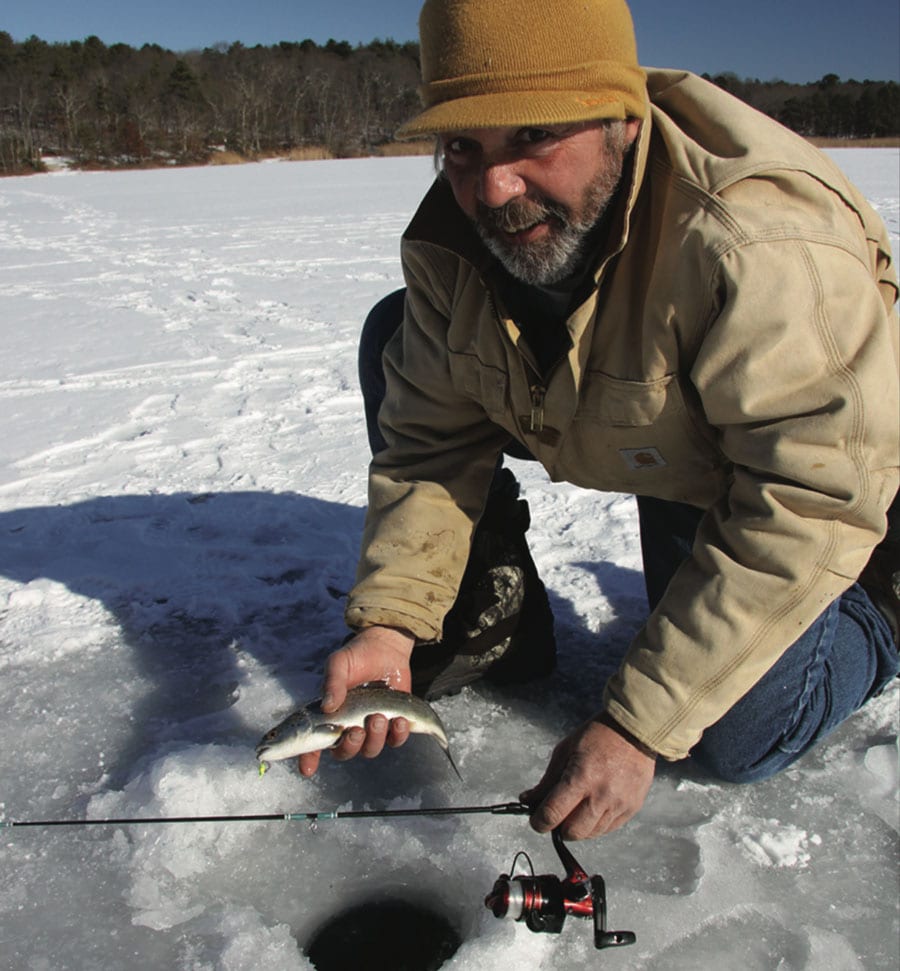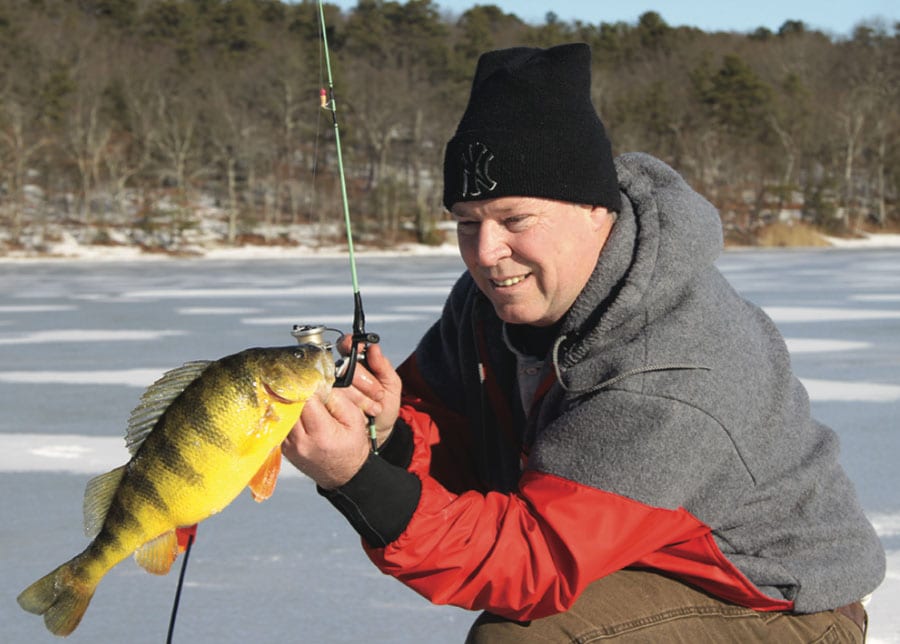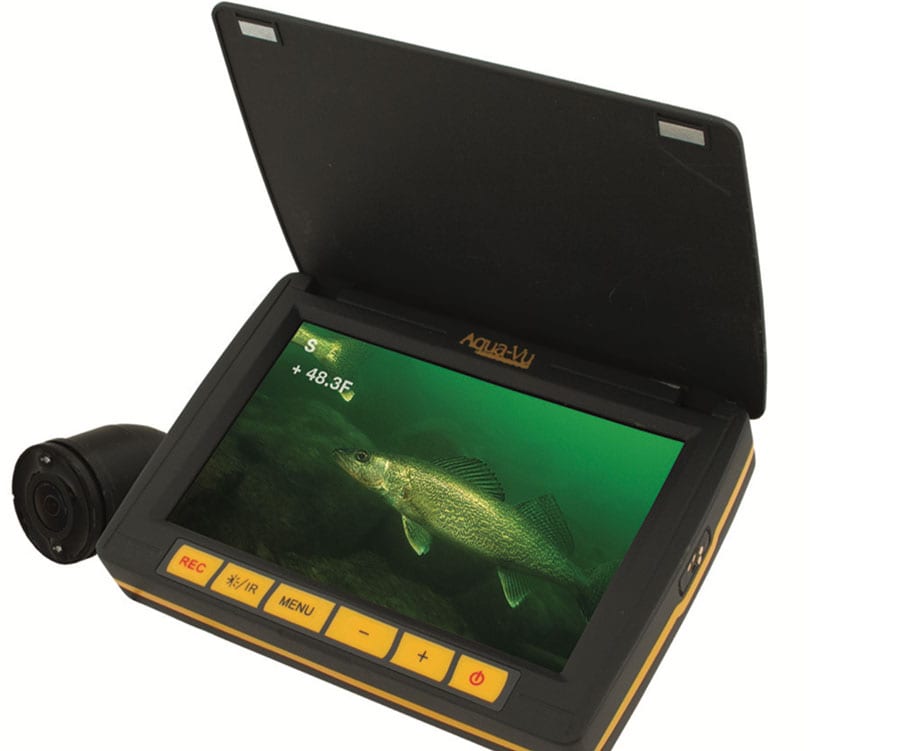BY TOM SCHLICHTER

In decades past, ice fishermen drilled a few holes in a specific area and worked them thoroughly – all day long, if necessary – until finally figuring out just what it was the fish wanted to smack. These days, ice anglers tend to be a lot more mobile. With lightweight augers and ever-improving electronics, today’s hard water anglers are willing and able to cover more territory if they don’t connect right out of the gate. This new approach is called ice trolling and the basic theme can be distilled down to one simple premise: cover more water scientifically and you’ll cross paths with more fish.
While it might sound like a simple idea to grab one of the latest “through the ice” fish-finders and simply start drilling holes across your favorite hot spot, the real key to ice trolling is formulating a game plan and sticking to it. That means specking out where you want to prospect and figuring out a pattern for the holes you’ll drill that make the most sense. You might, for example, drill only over structure, along a slope, or across a particular depth range such as 6 to 12 feet deep.
Once you start drilling, keep drilling until all the holes you expect to sh in a particular area are done. en go back and
clean each one out before testing it by dropping down an underwater camera or small jig to see what’s around. If this seems like a bit much, it can be when you fish alone. For that reason, ice trolling works best in teams of two or more people. One angler drills the holes, the next angler(s) cleans them up and checks for fish spending no more than five or ten minutes at a hole before moving on unless appropriate quarry is spotted or caught. In this way, it’s possible to cover a tremendous amount of ice in a very short time.

On large, open lakes in the Midwest, deep woods regions and Canada where the technique is practiced with abandon by anglers using portable ice fishing tents or shelters, equipment sleds and snow mobiles to aid in getting around, anglers can cover miles in a day if they so choose. Here in the Northeast the waters are far more intimate. To me, that actually increases the call for “trolling” because you know the sh are in the lake somewhere and you should be able to easily cover most potential hot spots in a single day if you have a topo map, are familiar with the water, or gather GPS way-points from a boat earlier in the season.
For those new to the ice trolling game, prominent points make a logical starting place on just about any lake or pond, especially when targeting warm water species like sun sh, bass, pickerel and yellow perch. Once safe ice (a minimum of 4 inches thick) has been assured, lay out a pattern that follows the point from a depth of several feet close to shore on out as deep as seems reasonable. On larger, deeper lakes you’ll have to look a little more carefully to spot gentle slopes. In either case, be sure to drill holes over any submerged weed beds, sunken logs or pronounced bottom structure with which you are familiar.

Cold water lovers, like trout and walleye, require a slightly different approach, although the same basic theory is at work. These species prefer water depths of 10 to 40 feet or more when available. They also generally like a clean bottom of gravel or sand and feel no need at all to be close to shore. For these sh, drill a path that covers a slope, sand bar or small hump well off the beach, or simply work water where you caught trout during the late fall period. You’ll likely find yellow and white perch in these deeper areas as well, and nothing precludes a chunky largemouth or smallmouth bass from wandering into such places to stretch their fins now and again.
No matter what you fish for, keep moving along. The idea is to go to the fish rather than wait for them to come to you. No bites while jigging after five or ten minutes? Move on to the next hole, and the next, and the one after that. On larger lakes, ice trollers tend to fish with lures or bait using ice-fishing jigging rods. That’s because they are going to keep moving forward with no looking back if a hole fails to produce.
On smaller lakes, however, where perhaps you are simply working a cove mouth or single small point, you can hedge your bets by placing a tip-up or two in well-spaced holes that failed the initial test. Often, such follow-ups will produce a big, cautious pickerel, bass or trout. But there’s a trade-off: If you set tip-up in your hard water wake, you’ve got to stay in the general area to watch for flags. On big lakes, doubling back becomes a drag on the search.
One point to keep in mind with this aggressive drilling is that you’ll need to mark every hole so that is easily visible to other resource users like ice boaters, ice skaters and people just stepping out on the ice out of curiosity. One way to do this is to pile the slushy ice removed from any hole immediately alongside it. Pile it high enough to be obvious as you don’t want anyone accidentally stepping into a hole, especially once the surface has refrozen enough to blend in with the surrounding ice.

Electronic options for ice anglers are rapidly expanding. Just a few years ago, flasher style fish-finders were your only affordable choice. Now, companies like Aqua-Vu let you actually see what is happening beneath the ice. The Aqua-Vu Micro 5.0 Revolution Pro, for example, sports a compact screen that’s slightly larger than a cell phone and features an integrated camera reel that eliminates camera cable tangles. It’s images are so sharp you can count the specks on a crappie.
BY TOM SCHLICHTER









